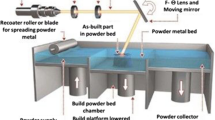Abstract
Numerous numerical models of mimicking cellular structures have been proposed, but, in many cases, those models were not able to describe the random cell geometry which is common for most cellular products. The concept of Voronoi tessellation has recently applied to construct the random characteristics of cell structures, but the structure generated by classical Voronoi tessellation method is too ideal by comparing with the actual cell structures. Moreover, the verification of physical and mechanical behaviors of random cell structures is scarcely researched due to the complexity of fabricating the cell structures which are numerically generated. In this study, Central Voronoi Tessellation (CVT) theory which considers the center of mass of each cell for further iteration of cell structure modification is adopted to generate realistic shape of cell structures. Some key parameters such as relative density, anisotropy, and number of iteration are considered. Mechanical behaviors of samples with numerically generated cell structures are investigated using elasto-plastic finite element analysis considering instability conditions. In addition, test samples in some cases considered in FEA are fabricated by aluminum alloy using 3-D printer based on the selective laser melting (SLM) technique, and the test results are compared with the numerical simulation results.
Similar content being viewed by others
Abbreviations
- p p :
-
point of seed
- R k :
-
Voronoi cell
- E f :
-
modulus of Foam
- E s :
-
modulus of solid
- σ f :
-
yield stress of foam
- σ s :
-
yield stress of solid
- ρ f :
-
density of foam
- ρ s :
-
density of solid
- RD:
-
Relative density = ρ f / ρ s
References
Gibson, L. J. and Ashby, M. F., “Cellular Solids: Structure and Properties,” Cambridge University Press, pp. 176–217, 1997.
Li, K., Gao, X.-L., and Wang, J., “Dynamic Crushing Behavior of Honeycomb Structures with Irregular Cell Shapes and Non-Uniform Cell Wall Thickness,” International Journal of Solids and Structures, Vol. 44, No. 14, pp. 5003–5026, 2007.
Song, Y., Wang, Z., Zhao, L., and Luo, J., “Dynamic Crushing Behavior of 3D Closed-Cell Foams based on Voronoi Random Model,” Materials & Design, Vol. 31, No. 9, pp. 4281–4289, 2010.
Han, W.-H., Choi, B.-H., Kim, I.-H., and Lee, J.-M., “Modeling of the Elasto-Plastic Deformation Behavior of Two-Dimensional Anisotropic Foam under Compressive Loads using Voronoi Cells,” J. Korean Soc. Precis. Eng., Vol. 29, No. 7, pp. 785–792, 2012.
Li, Z., Zhang, J., Fan, J., Wang, Z., and Zhao, L., “On Crushing Response of the Three-Dimensional Closed-Cell Foam based on Voronoi Model,” Mechanics of Materials, Vol. 68, pp. 85–94, 2014.
Sotomayor, O., “Numerical Modeling of Random 2D and 3D Structural Foams using Voronoi Diagrams: a Study of Cell Regularity and Compression Response,” M.Sc. Thesis, Department of Mechanical Engineering, Auburn University, 2013.
Ghosh, S. and Mukhopadhyay, S. N., “A Material based Finite Element Analysis of Heterogeneous Media Involving Dirichlet Tessellations,” Computer Methods in Applied Mechanics and Engineering, Vol. 104, No. 2, pp. 211–247, 1993.
Lloyd, S. P., “Least Squares Quantization in PCM,” IEEE Transactions on Information Theory, Vol. 28, No. 2, pp. 129–137, 1982.
Du, Q., Faber, V., and Gunzburger, M., “Centroidal Voronoi Tessellations: Applications and Algorithms,” SIAM Review, Vol. 41, No. 4, pp. 637–676, 1999.
Du, Q., Emelianenko, M., and Ju, L., “Convergence of the Lloyd Algorithm for Computing Centroidal Voronoi Tessellations,” Siam Journal on Numerical Analysis, Vol. 44, No. 1, pp. 102–119, 2006.
Emelianenko, M., Ju, L., and Rand, A., “Nondegeneracy and Weak Global Convergence of the Lloyd Algorithm in R d,” SIAM Journal on Numerical Analysis, Vol. 46, No. 3, pp. 1423–1441, 2008.
Du, Q. and Gunzburger, M., “Grid Generation and Optimization based on Centroidal Voronoi Tessellations,” Applied Mathematics and Computation, Vol. 133, No. 2, pp. 591–607, 2002.
Maurer, M., Choi, B.-H., Sehanobish, K., and Vogel, G., “Modeling the Compressive Fracture Behavior of Foams for Energy Absorption,” Journal of Cellular Plastics, DOI No. 10.1177/0021955X11401732, 2011.
Kempen, K., Thijs, L., Van Humbeeck, J., and Kruth, J.-P., “Mechanical Properties of AlSi10Mg Produced by Selective Laser Melting,” Physics Procedia, Vol. 39, pp. 439–446, 2012.
Rafi, H. K., Karthik, N. V., Gong, H., Starr, T. L., and Stucker, B. E., “Microstructures and Mechanical Properties of Ti6Al4V Parts Fabricated by Selective Laser Melting and Electron Beam Melting,” Journal of Materials Engineering and Performance, Vol. 22, No. 12, pp. 3872–3883, 2013.
Rafi, H. K., Starr, T. L., and Stucker, B. E., “A Comparison of the Tensile, Fatigue, and Fracture Behavior of Ti-6Al-4V and 15-5 PH Stainless Steel Parts Made by Selective Laser Melting,” The International Journal of Advanced Manufacturing Technology, Vol. 69, No. 5-8, pp. 1299–1309, 2013.
Brandl, E., Heckenberger, U., Holzinger, V., and Buchbinder, D., “Additive Manufactured AlSi10Mg Samples using Selective Laser Melting (SLM): Microstructure, High Cycle Fatigue, and Fracture Behavior,” Materials & Design, Vol. 34, pp. 159–169, 2012.
Simone, A. and Gibson, L., “Effects of Solid Distribution on the Stiffness and Strength of Metallic Foams,” Acta Materialia, Vol. 46, No. 6, pp. 2139–2150, 1998.
Aboulkhair, N. T., Everitt, N. M., Ashcroft, I., and Tuck, C., “Reducing Porosity in AlSi10Mg Parts Processed by Selective Laser Melting,” Additive Manufacturing, Vols. 1-4, pp. 77–86, 2014.
Author information
Authors and Affiliations
Corresponding author
Rights and permissions
About this article
Cite this article
Park, SY., Lee, JS., Choi, BH. et al. Modeling and observation of compressive behaviors of closed celullar structures using central Voronoi tessellation concepts. Int. J. Precis. Eng. Manuf. 16, 2459–2465 (2015). https://doi.org/10.1007/s12541-015-0316-6
Received:
Revised:
Accepted:
Published:
Issue Date:
DOI: https://doi.org/10.1007/s12541-015-0316-6




